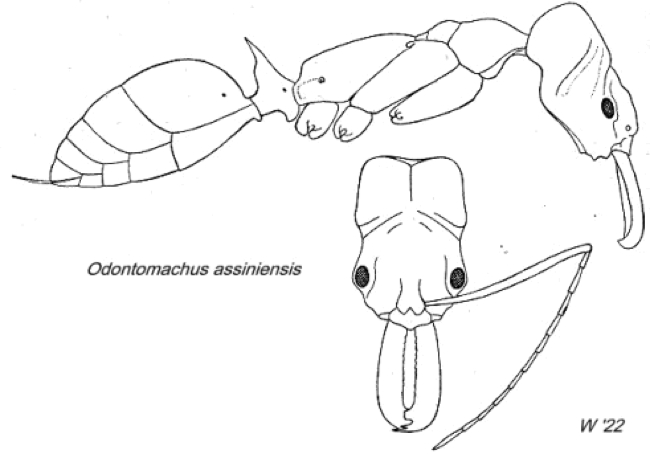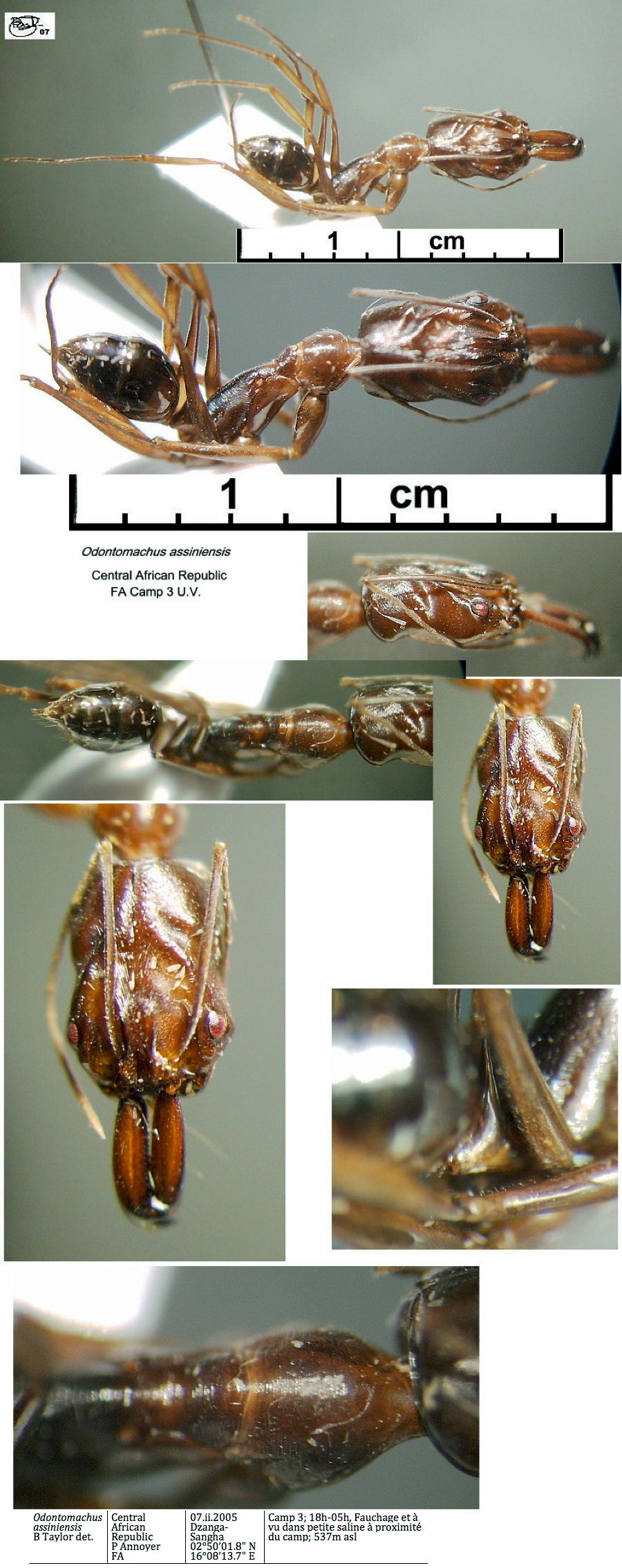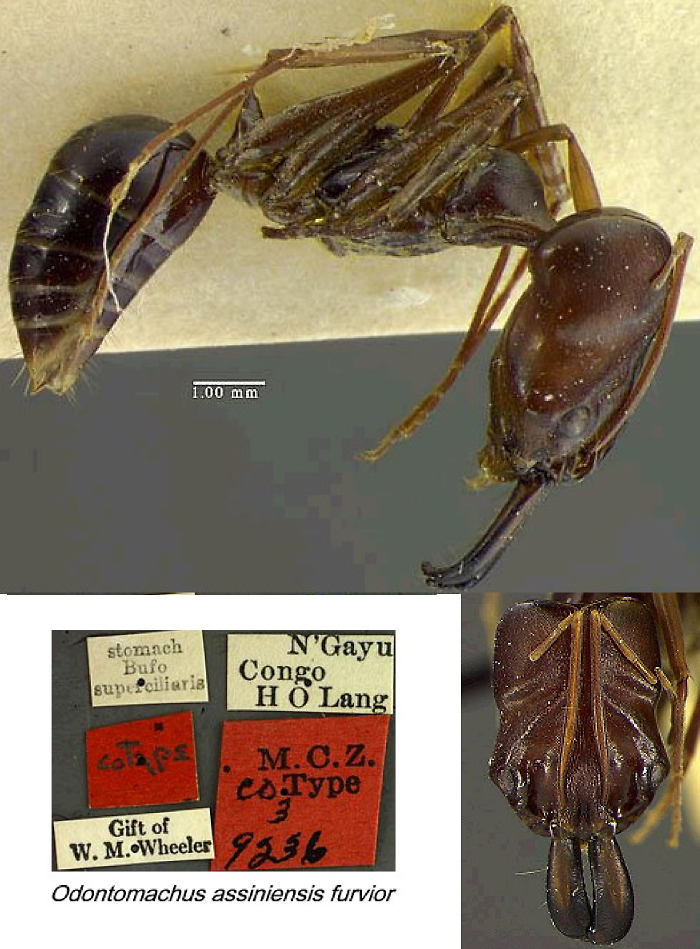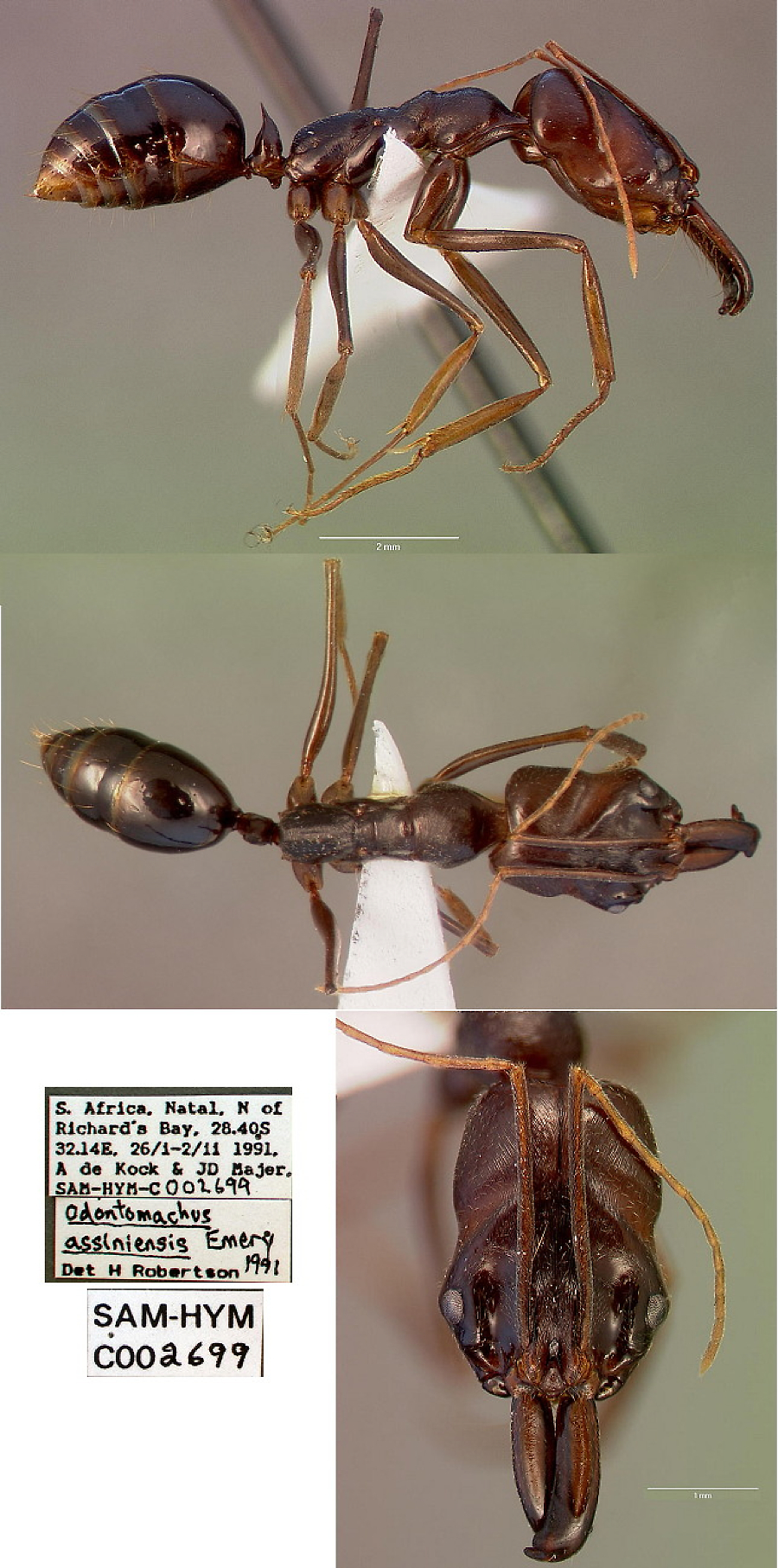Odontomachus assiniensis Emery
  Type location Ivory Coast
(Odontomachus assiniensis n.
sp., Emery, 1892d: 558, worker; Santschi, 1910c: 350, queen; Forel,
1913e:
666, queen & male; Santschi, 1914b: 57, male) collected at Assinie
by Ch. Alluaud, vii-viii.1886 Type location Ivory Coast
(Odontomachus assiniensis n.
sp., Emery, 1892d: 558, worker; Santschi, 1910c: 350, queen; Forel,
1913e:
666, queen & male; Santschi, 1914b: 57, male) collected at Assinie
by Ch. Alluaud, vii-viii.1886
junior synonyms (Brown, 1976a: 102, Bolton 1995)
aterrimus (Odontomachus
assiniensis variety aterrimus
n. variety, Wheeler, 1922: 102, worker) from Zaïre, Niapu - see http://www.antweb.org/specimenImages.do?code=casent0104655
fauconneti (Odontomachus
assiniensis Em. subsp. Fauconneti
n. subsp., Forel, 1910a: 27, worker) from Zaïre, Bakai - see http://www.antweb.org/specimenImages.do?code=casent0907424
furvior (Odontomachus
assiniensis variety furvior
n. variety, Wheeler, 1922: 101, worker & queen)
from Zaïre, Faradje - see http://www.antweb.org/specimenImages.do?code=casent0104656
fuscus (Odontomachus
assiniensis Em. v. fuscus
n. v., Stitz, 1916: 372, worker & queen) from Zaïre, Duma,
Ubangi - no images on Antweb (June 2014)
caffrorum (Odontomachus
assiniensis Em. stirps caffrorum
n. st., Santschi, 1914e: 14, worker) from South
Africa, Zululand, Dukudu, ix.1905 - no images on Antweb (June 2014)
flavescens (Bernard, 1952: 215, worker & queen)
from Guinea, Mt. Nimba - see http://www.antweb.org/specimenImages.do?code=casent0915470
intermedius (Odontomachus
intermedius n. sp., Stitz, 1911b: 378, worker) from Tanzania,
N W Bukoba - no images on Antweb (June 2014)
tropicalis (Odontomachus
assiniensis var. tropicalis
n. v., Menozzi, 1922a: 353, all forms) from Principé
Is - no images on Antweb (June 2014)
plus the unavailable and unnecessary name oblita (for fuscus
Baroni Urbani, 1971b: 360)
all forms known  . .
|
 Emery's (1892d) description is at Emery's (1892d) description is at  . Santschi's (1910c) descriptions of the
queen is at . Santschi's (1910c) descriptions of the
queen is at  . Forel's (1913e)
descriptions of the male and queen are at . Forel's (1913e)
descriptions of the male and queen are at  . Forel's (1910a) description of fauconneti
is at . Forel's (1910a) description of fauconneti
is at  . Stitz's (1911b)
description of intermedius is at . Stitz's (1911b)
description of intermedius is at  . Santschi's (1914e) description of the
male is at . Santschi's (1914e) description of the
male is at  . Santschi's (1914e)
description of caffrorum is at . Santschi's (1914e)
description of caffrorum is at  . Stitz's (1916)
description of fuscus is at . Stitz's (1916)
description of fuscus is at  . Menozzi's (1922a) description of tropicalis
is at . Menozzi's (1922a) description of tropicalis
is at  . Wheeler's (1922: 101,
102) commentary, with descriptions of furvior and aterrimus,
is at . Wheeler's (1922: 101,
102) commentary, with descriptions of furvior and aterrimus,
is at  . Arnold (1926: 218) provided an
illustrated translation of caffrorum, plus a commentary on the
differences from troglodytes; this is at . Arnold (1926: 218) provided an
illustrated translation of caffrorum, plus a commentary on the
differences from troglodytes; this is at  . Brown's revision (1976a: 128) is at . Brown's revision (1976a: 128) is at  . .
|
 Emery (1899e:
476) noted that his original description of
a single specimen from Assinie, Ivory Coast (1892d), was of a medium
size worker with a reddish head. On receipt of several specimens from Cameroun,
collected by L Conradt, Emery found a TL range from 11.0-14.0 mm; head
size range HL 3.0 HW 2.1 to HL 3.6 HW 2.8 mm. Emery (1899e:
476) noted that his original description of
a single specimen from Assinie, Ivory Coast (1892d), was of a medium
size worker with a reddish head. On receipt of several specimens from Cameroun,
collected by L Conradt, Emery found a TL range from 11.0-14.0 mm; head
size range HL 3.0 HW 2.1 to HL 3.6 HW 2.8 mm.
WORKER - no size given by Brown (1976a) but "averages
larger in size" (than troglodytes) [Emery (1899e) gave TL
11.0-14.0 mm], with a higher, more compressed petiolar node. Also
differentiated by 4-segmented labial palps. Colour variable from all
over brown, most commonly with yellow legs; Ghana forest zone
individuals often with a red head and yellow legs.
Widespread in warmer parts of sub-Saharan Africa.
Wheeler (1922) listed findings from Ghana (Aburi, F.
Silvestri), Togo (Bismarckburg, Conradt, Büttner; Misahöhe,
Baumann), Cameroun (Bartsch at ?; Molundu by Schultze;
Mundame, L. Conradt; Soppo, von Rothkirch), and several other
sub-Saharan records.
Bernard (1952) described it as less common and more
localised than "haematodus" (troglodytes), more often
found in the forests of Congo westwards than in eastern Africa (where
it was conspicuous in the mountains of Kenya and Mozambique). The Guinea
form, which was very abundant in Lamotte's collections, was notable for
its yellow head (other forms being red-brown), entirely yellow tarsi
(others with brown femurs), and, the propodeum partly black and shiny
(others brown-red and dull). Otherwise the Nimba forms differed little
from the Ivory Coast type, although the thorax was more shiny and the
petiole spine straighter and sharper. The combination led to his
designation of the subspecies flavescens (illustrated scan of
photocopy of photo). This seems to be a form of higher levels, with the
yellow colour being constant across the massif. Findings were from
Kéoulenta, type worker and 2 other, plus 1 queen. Numerous cotype
workers were collected from Yalanzou; Nion; Camp IV, 1000 m; Zouépo,
grassland at 1050 m; Nion crest, 1300 m, scrub; Mount Tô, 1600 m.
Ledoux (1952) reported preliminary research on the
species, including determining that the major food was termites,
although other kinds of small insects found during its surface foraging
were taken. The larger prey were stung but smaller insects were killed
by a simple mandibular strike.
Reported from Ghana cocoa leaf litter and
nesting in dead wood on the ground, also from low scrub, at the Mampong
Cemetery farm (Room, 1971). A single collection of eight workers from
secondary forest at CRIG (23.xii.1991), was made by Belshaw &
Bolton (1994b).
|
 The
photomontage of the type worker is collated from http://www.antweb.org/specimen.do?name=casent0904001. The
photomontage of the type worker is collated from http://www.antweb.org/specimen.do?name=casent0904001.
|
Oxford University Museum
specimens |
 The
photomontage is of a worker from Congo, Réserve de Lésio-Louna; collector Eric Zassi (04-t-2-1). The
photomontage is of a worker from Congo, Réserve de Lésio-Louna; collector Eric Zassi (04-t-2-1).
|
 The photomontage is of
a worker from the Central
African Republic, Dzanga-Sangha NP; Camp 3; 02°50’01.8" N
16°08’13.7" E 375m; 07.ii.2005, U.V : 18h-5h, dans petite saline à
proximité du camp; collector Philippe Annoyer. The photomontage is of
a worker from the Central
African Republic, Dzanga-Sangha NP; Camp 3; 02°50’01.8" N
16°08’13.7" E 375m; 07.ii.2005, U.V : 18h-5h, dans petite saline à
proximité du camp; collector Philippe Annoyer.
|
 The photomontage
is of a queen from the Central
African Republic, Dzanga-Sangha NP; Bayanga-Lidjombo; 07.vi.1998;
10.30-12.30 h, collector Philippe Annoyer. The photomontage
is of a queen from the Central
African Republic, Dzanga-Sangha NP; Bayanga-Lidjombo; 07.vi.1998;
10.30-12.30 h, collector Philippe Annoyer.
|
 The
photomontage is of a cotype of Odontomachus
assiniensis furvior from Zaïre. The original photographs,
together with enlarged images, are from the MCZ, Harvard University,
website at - MCZ link. The
photomontage is of a cotype of Odontomachus
assiniensis furvior from Zaïre. The original photographs,
together with enlarged images, are from the MCZ, Harvard University,
website at - MCZ link.
|
 The photomontage is
collated from http://www.antweb.org/specimen.do?name=sam-hym-c002699a
Collection details - South Africa: Natal: north of Richards Bay;
28°40'00"S 032°14'00"E Collection Information Collection codes:
SAM-HYM-C002699 Date: 26 Jan-2 Feb 1991 Collected by: A.de Kock,
J.D.Majer : Natal: north of Richards Bay; 28°40'00"S 032°14'00"E
Collection Information Collection codes: SAM-HYM-C002699 Date: 26 Jan-2
Feb 1991 Collected by: A.de Kock, J.D.Majer . The photomontage is
collated from http://www.antweb.org/specimen.do?name=sam-hym-c002699a
Collection details - South Africa: Natal: north of Richards Bay;
28°40'00"S 032°14'00"E Collection Information Collection codes:
SAM-HYM-C002699 Date: 26 Jan-2 Feb 1991 Collected by: A.de Kock,
J.D.Majer : Natal: north of Richards Bay; 28°40'00"S 032°14'00"E
Collection Information Collection codes: SAM-HYM-C002699 Date: 26 Jan-2
Feb 1991 Collected by: A.de Kock, J.D.Majer .
|
|